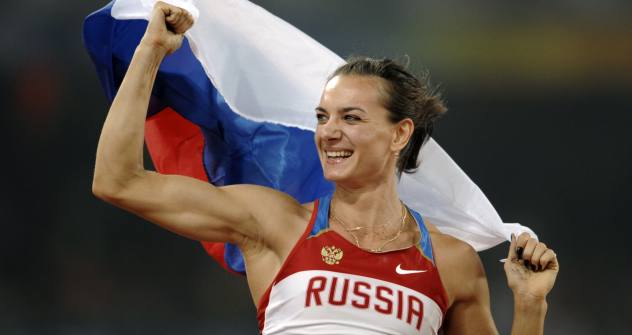High hopes for Isinbaeva at London

five-time world champion Yelena Isinbaeva has broken 28 records. She goes into the Olympic competition as defending champion. Source: AFP / East News
At the start of the year, many commentators
predicted that the Russian pole vault champion Yelena Isinbaeva would retire
because of a string of setbacks, notably injuries and poor form. But Isinbaeva
has confounded her critics by recapturing her best form and, at the age of 29,
she is not only determined to carry on with her career, but has set her sights
on a new world record and winning another gold medal at this summer’s Olympic
Games in London.
One of the most harrowing memories of
Isinbaeva’s career was when she buried her face in her hands at the 2009 Berlin
World Championships after her third failed vault. Her coach, Vitaly Petrov, who
also trained the legendary pole vault world champion Sergei Bubka, was
crestfallen, and her loyal fans were dismayed. But then came another
setback at the Doha Indoor World Championship in 2010 when she
failed to win the gold medal.
Fans had become so used to her imperious form that a simple win without
breaking a record was disappointing. Suddenly, she was failing to win
competitions, let alone set new world records .
What went wrong? Everyone needs a rest from time to time, but it seems that
Isinbaeva needed more than rest to return to form.
When she dismissed former coach Yevgeny Trofimov, with whom she had worked
successfully since late 1997, after the Athens Olympics in 2004, it came as a
shock. Trofimov had led her by the hand to the Olympic gold medal in Athens in 2004 and their
relationship had flourished, bringing sporting glory.
Isinbaeva wanted to learn a new jumping technique under the guidance of new
coach Petrov . She was of fered two talented foreign managers who committed her
to lucrative contracts. She would take part in a competition one day and rush
off to a remote part of China to fulfil key contractual duties the next, only
to face another commercial tour a couple of days later.
Moving from her home in Volgograd to Monaco to be
closer to the tournaments seemed to be a sensible thing to do. Here, she could
train all year under an azure sky within a stone’s throw of her
new house. But she missed her friends, sisters and parents, and none of the
other Russian athletes were there to keep her company.
Was it realistic to hope that her coach
Petrov could entirely replace her friends and family? She was not a recluse by
nature, but she was spending far too much time alone in Monaco.
Under Petrov, Isinbaeva perfected the new jumping technique. She had set her
first world record of 4.82m back in 2003; she took gold in Beijing in 2008 with a new world record mark
of 5.05m.
But then came the setbacks. After Doha
in 2010 she announced: “I have decided to take an indefinite break.” It seemed
even Isinbaeva could not defy nature and her ageing muscles. She was spending
more time on the treatment table and missed several tournaments. The new
jumping technique was turning out to be a success and Petrov was making steady
progress in improving her performance. But she was no longer threatening to
break records and the bar was often knocked to the ground.
Retirement threat
After going home to Volgograd in spring
2011, Isin-
baeva
decided she did not want to return to Monaco. She did not even want to
train any more and was considering retirement. However, on Shrove Sunday (the
Orthodox day of forgiveness) she telephoned Trofimov and asked him to meet her.
The trainer had by that time forgiven
Isinbaeva for her decision to replace him and had been watching his former
charge’s career with interest. They met in a small, deserted restaurant.
Isinbaeva did most of the talking. She was crying: she had left her home in Monaco, and she
wanted Trofimov to be her coach again. If he refused, she would retire from the
sport she loved for good.
Trofimov realised that it would be wrong of him to let such a talented athlete
end her career and said he would think about it.
On March 8, International Women’s Day, a popular holiday in Russia when women
traditionally receive gifts, Isinbaeva was sitting at Trofimov’s dining table
with her parents.Coach and athlete had been separated for five years, but the
man who had turned her into a champion at a such an early age believed he knew
what was missing and what could be done to help her rediscover her winning ways
.
It seems that, like most people, Isinbaeva could not stand being away from her
friends and loved ones for long. Once in 2007 when she was living abroad and
seemed to be happy, I asked her about the rumours that she was going to take
foreign citizenship; she took it as a serious insult. “Never, not even for 100
million greenbacks,” she snapped. If there is such a thing as a true patriot,
then Isinbaeva is one.
Since her return to Russia,
Isinbaeva has worked very hard and is starting to find her form.
Although she failed to win a medal at the World
Championships in Daegu, South Korea last year, this year she
set a new world indoor record of 5.01m in Stockholm and won gold at the World
Championships in Istanbul. It was at Crystal
Palace, London, in 2005, that Isinbaeva became the
first female pole vaulter to clear 5m. But who knows if she will have as much
success in London
this year; she has had many injuries and disappointments. Some commentators in
the Russian press have said she will take gold , but I’m not prepared to stick
my neck out and predict that she’ll win in London.
Inevitably, many strong rivals have appeared in the past two years. One of them
is Britain’s
bright hope Holly Bleasdale who, at the age of just 20, can jump higher than
the Russian could at the same age. Bleasdale recently smashed the British
indoor record in Lyon with a clearance of
4.87m to become the second highest female pole vaulter in the world – after
Isinbaeva .
I’ll predict just one thing. I think Isinbaeva will make three attempts in London. The first jump
with a pink pole will be a warm up, challenging the stronger of her rivals. She
will come out with her blue pole when only a few of the strongest rivals still
remain. And God willing, she will come out with her golden pole when it’s time
to beat the world record.
Nikolai Dolgopolov is deputy editor-in-chief of Rossiyskaya Gazeta.
All rights reserved by Rossiyskaya Gazeta.
Subscribe
to our newsletter!
Get the week's best stories straight to your inbox

